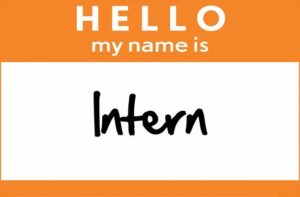 The labor market is as tight as ever since the Great Recession began back in 2007.
The labor market is as tight as ever since the Great Recession began back in 2007.
- Unemployment is at a record low 4.1 percent;
- Highly skilled workers are in short supply, but big in demand; and,
- The oldest members of the workforce – mostly Baby Boomers – are retiring.
These conditions have left employers feverishly looking for qualified candidates to recruit, hire and retain, and they’re upping the ante to do it.
Some companies are willing to raise wages to attract talent. Others are offering employees one-time bonuses and stock awards, expanding their benefits portfolios, and pouring more money into 401(k)s with windfalls from the new tax bill.
But what they could be doing instead is looking for more pools of talent, specifically, the least costly of them all — interns.
Students at the high school and college levels often find internships rewarding. The chance to get hands-on work experience, academic credit and a possible job offer after graduation counter-balances the lack of pay. In fact, career advisers agree that getting seen by an employer can be the best route to a job.
Whether to pay, or not to pay?
 Who would have thought that an 11th Century work arrangement like an internship would be central to a 21st Century debate?
Who would have thought that an 11th Century work arrangement like an internship would be central to a 21st Century debate?
Under the Obama Administration, the U.S. Department of Labor decided that all interns must be paid at least the federal minimum wage plus overtime to comply with the Fair Labor Standards Act (FLSA). The department also came up with a six-point set of criteria for employers hiring interns to meet.
Some of DOL’s concerns at that time were:
- For-profit companies were using interns for free labor;
- Companies were replacing paid employees with unpaid interns;
- Interns weren’t being supervised in an academic capacity; and,
- Many interns were assigned drudgery work.
Although some companies might have been violating federal and state wage and hour laws, the sweeping change stood to penalize both companies and interns who benefited from the relationship.
In January 2018, Secretary of Labor Alexander Acosta announced a rollback of the rule and its six-point criteria. Under the revised rule, for-profit employers must still pay interns for their work. However, in some cases, interns and students might not be classified as employees under the FLSA and therefore aren’t required to be paid.
A new test to determine if an intern is an employee
 A seven-point “primary beneficiary test, used by the courts, will determine whether an intern is an employee. The test is designed to uncover who benefits most from the internship, the employer or the intern, and what both parties understand about the relationship’s terms.
A seven-point “primary beneficiary test, used by the courts, will determine whether an intern is an employee. The test is designed to uncover who benefits most from the internship, the employer or the intern, and what both parties understand about the relationship’s terms.
According to the Labor Department, the Courts have identified the following seven factors as part of the test:
- The extent to which the intern and the employer clearly understand that there is no expectation of compensation. Any promise of compensation, express or implied, suggests that the intern is an employee—and vice versa.
- The extent to which the internship provides training that would be similar to that which would be given in an educational environment, including the clinical and other hands-on training provided by educational institutions.
- The extent to which the internship is tied to the intern’s formal education program by integrated coursework or the receipt of academic credit.
- The extent to which the internship accommodates the intern’s academic commitments by corresponding to the academic calendar.
- The extent to which the internship’s duration is limited to the period in which the internship provides the intern with beneficial learning.
- The extent to which the intern’s work complements, rather than displaces, the work of paid employees while providing significant educational benefits to the intern.
- The extent to which the intern and the employer understand that the internship is conducted without entitlement to a paid job at the conclusion of the internship.
As the Labor Department Fact Sheet notes,
“Courts have described the ‘primary beneficiary test’ as a flexible test, and no single factor is determinative. Accordingly, whether an intern or student is an employee under the FLSA necessarily depends on the unique circumstances of each case.”
A long history worth preserving
Internships have a long history dating back to Medieval times. The term “intern” originated in the medical community.
By World War I, “intern” referred to a doctor who had a medical degree but no license to practice. The term now applies to broader categories of workers, but the idea is the same; interns might have diplomas or degrees, but they need hands-on experience to succeed in their field.
Some very famous, highly successful people have been interns, including Bill Gates, Spike Lee, Steve Jobs, Oprah Winfrey, Steven Spielberg and Brooke Shields. They’re all described as having “worked their way” up into interesting professions.
Will these high-profile people inspire emerging generations to become interns – paid or unpaid? Many young adults want a “foot in the door,” but for some, internships turn out to be “go for” jobs with no real learning opportunities.
The question of pay resurfaces when young people from low-income backgrounds feel that they can’t afford to take any job – no matter how great or how grueling – that doesn’t pay.
What recruiters and employers can do
Companies must first comply with wage and hour laws when recruiting and hiring interns, because penalties for noncompliance can be steep. Companies also can try to make internships as productive as possible by:
- Making learning the focus of the internship;
- Mixing meaningful work assignments that align with interns’ goals with more mundane tasks;
- Paying low- and middle-income interns a wage, if possible;
- Partnering with schools to provide interns with professional development; and,
- Identifying exceptional interns as potential hires.
Authors
Valerie Bolden-Barrett
Valerie Bolden-Barrett is a business writer and content specialist, covering best business practices, human resources and management, public policy, employment law, and workplace issues and trends. She’s a former editor of national business publications at Simon & Schuster and a senior editor at Aspen Publishers. She’s a Temple University alumna, living in Central Connecticut. Connect with Valerie on LinkedIn.
Recruit Smarter
Weekly news and industry insights delivered straight to your inbox.






